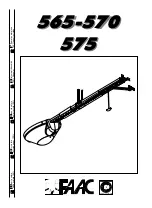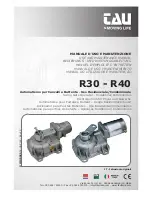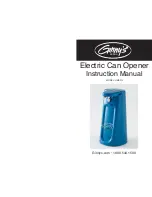
L I V I
Operating instructions and warnings
10
4.6 Training
After installation and setting, the correct operation of the
complete automatism must be carefully illustrated to the final
user.
The LIVI gate operator requires careful instruction on the
release mechanism (see “Enclosures”) in particular and the res-
pective maintenance schedule (see Point 4.5.6.).
WARNING
Awareness of the operation of the LIVI key-re-
lease mechanism (see F9 Page 32) is essential for all users of
the automatism because the failure to use the device quickly
during emergencies can jeopardise people, animals and pro-
perty. Enclosure I to these instructions, which the installer is
required to deliver to the final user, illustrates operation and
can be detached.
4.7 Inappropriate use
Chapter “4.4 Appropriate conditions of use” describes the
conditions for which the product has been designed and tested.
The product must never be used for other purposes.
WARNING
The use of the product under unusual conditions
not foreseen by the manufacturer can create situations of dan-
ger, and for this reason all the conditions prescribed in these
instructions must be respected.
WARNING
Under no circumstances must the product be
used in explosive atmospheres or surroundings that may prove
corrosive and damage parts of the product.
5 SPARE PARTS LIST
The list of spare parts that can be ordered (Pages 28, 29 and
33) is a detailed list that accompanies the exploded view of the
product and must be used to order spare parts.
The following data must always be provided when ordering
spare parts:
• the code of the product (seen on the product label; see F5,
Page 31),
• the part’s position number in the exploded view,
• if available, the product’s purchase date may be useful in
some cases.
6 COMPLETE CLOSING ASSEMBLY
This chapter illustrates the typical installation of a comple-
te automatism for the purpose of informing and assisting the
installer in the selection of the various parts to be used in com-
pliance with Machinery Directive (2006/42/CE) and European
Safety Standards (EN 14453 - EN 12445) for gate installation.
The data provided in this chapter are neither complete nor
exhaustive, and
DEA
System declines all liability for any errors,
omissions or inaccuracies that may occur.
6.1 Minimum level of protection provided by the
safety edge
The risk of getting crushed between the gate and the fence
or wall and/or other fixed parts is among the most serious risks
to be considered when automating a sliding gate is. An appro-
priate type of operating control board must be used according
to the gate type and use against such risk, as provided for by the
quoted regulations (see “OPERATING CONTROL” table).
6.2 Crushing in the opening area
The risk of crushing can also arise in the area between the
gate being opened and the wall or other construction behind
it. F10 on Page 32 provides the measurements that must be
respected whenever measures are not taken to limit the impact
force or whenever presence detection systems are not used.
6.3 Impact in the opening/closing area
Install a pair of photocells on one or the other side of the
gate or on both in order to avoid the risk of impact with the gate
in the closing area. (recommended height: 500 mm) in order to
detect the presence of the test parallelepiped (height: 700 mm)
positioned as shown in F11 on Page 32.
Note. The presence detection test sample is a parallelepiped
with 3 sides with light-coloured reflecting surfaces and 3 sides
with dark-coloured, opaque surfaces.
Make sure there is no conflict when the photocells are instal-
led on both sides. The system working on the gate side where the
test sample is positioned must detect all test objects.
Содержание LIVI Series
Страница 1: ......













































